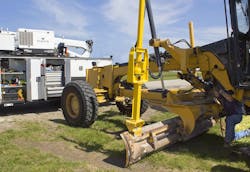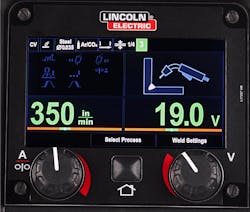Welders Show Gains in Safety, Productivity
Recent innovations within the welding segment have centered around safety and productivity, according to manufacturers.
Improved products and add-ons help keep costs down on site, and technology makes skilled worker tasks more intuitive. Using remote tools and hybrid machines, for example, improve the way welders perform.
According to Miller Electric, a typical welder makes adjustments to their weld parameters about four times a day on average. To do this, they must walk from the welding area to the power source—a trip that could take as long as 10 to 15 minutes. The revenue lost during that time totals to about $11,250 per welder per year, the company says.
“An operator may be several hundred feet away from where the unit is sitting,” says Jake Zwayer, product manager at Miller. “In cases where it’s too time-consuming to go back and forth, workers will forfeit making those adjustments, resulting in lower quality welds.”
To combat this, Miller ArcReach welding technology lets welders make parameter adjustments at the point of use. It uses the existing weld cable to communicate control information between a feeder and the power source, eliminating the need for control cords. This results in improved productivity, encourages best-practice welding, and improves safety by reducing tripping hazards.
Zwayer says welders usually make adjustments to two primary settings: their welding parameters and arc control.
“Filler metals can change based on what someone is welding, or even within a joint,” Zwayer says. “There are some joints where you have to use a 6010 electrode (an electrode with a quick, deep arc) first, for example, and then you may need to switch over to a 7018 (an electrode providing high levels of polish on difficult-to-melt metals).”
In other cases, workers quickly move from arc gouging (creating a hole or indentation on a metal surface) to stick welding. This process is used during equipment repairs.
“[Now they’re able to] carbon arc gouge the crack out, change processes to flux-cored arc welding, and then fill that crack in so it doesn’t propagate anywhere else,” Zwayer says. “They can also change the arc control or amperage setting to optimize their welding parameters after the transition.”
Miller also offers remote start and stop on Bobcat welder/generators. Remote start and stop allows welders to turn off their machines when they’re not in use, reducing fuel consumption, and noise. It also cuts strain on the engine, which reduces servicing frequency and associated preventive maintenance costs.
“The products can be started and stopped with a key fob,” Zwayer says. “Sometimes our engine drives run all day—welders turn them on in the morning and might turn them off at lunch. When you look at the useage profile of the equipment, typically it’s only being used by the operator 20 percent of the time.”
Units can be fixed to the back of a service truck while workers are elsewhere on site. If they need to make a quick weld, they can use the fob to start the machine, complete their tasks, and turn it off from where they are working.
“Instead of turning the welder on before they walked into the building or got in a bucket, they could just leave the unit off, and only turn it on when they need to,” he says.
Hybrid machines for service trucks are also growing in popularity, providing users with several workstation components in one piece of equipment. Vanair’s Air N Arc All-In-One Power System, for example, provides up to six forms of power in one machine. Configurations include a welder, generator, air compressor, battery booster, battery charger, and hydraulic output.
Instead of having separate equipment take up truck space—along with adding weight, which will increase fuel consumption—managers can now opt for one all-inclusive piece. Donnie Stone, sales support and training manager at Vanair, says with multi-function machines, the engine is exercised regularly so old fuel does not sit in the system.
“One of the complaints that you’ll hear is, ‘My brand X welder works phenomenally...when it’s running,’” he says. “Since the work requires the use of an air compressor 90 percent of the time, welding is actually very low on the ‘most used’ items on a service truck. Now when I need a weld, I flip the welder switch on, and away I go.”
Vanair has fine-tuned the amperage on these machines, according to Stone, offering a broader and finer range of weld adjustment. The system provides anywhere from 20 to 185 cubic feet of air per minute (cfm) of compressed air, and 150 to 400 amps of welding power.
“Many times in the field, a technician is making repairs from either a preventative maintenance standpoint or a safety standpoint,” he says. “As these problems come in, the Air N Arc system will have the correct power they need to repair on the spot.”
Workers also save time and money on preventive maintenance. Instead of changing oil on multiple engines, for example, they only need to service one.
“In fairly short order, you’d be able to see a return on investment,” he says.
To assist with accuracy, Lincoln Electric has released “Ready. Set. Weld.,” a feature that guides users through a weld setup within the machine’s interface. Theo Facaros, Lincoln Electric’s manager of rental and construction industries, noted a wire welding job as an example of the system’s functionality.
“If you’re doing wire welding, the first screen would ask the welder to enter information like wire weld type, wire diameter, wire process, and the gas,” he says. “You’d use a pushable rotary knob to select ‘steel’ or ‘stainless’ wire.”
After moving to the next screen, the system kicks out appropriate welding ranges to begin within. It also reminds the welder about how to properly set up the weld.
“The screen shows a long red line, and somewhere in the middle, there’s a green section,” Facaros says. “That green section is what the machine is recommending you start at.”
The system also allows users to adjust weld parameters. If they want to change the inductance, for example, the system breaks down how it would manipulate the welding arc.
“Is it widening the welding arch? Is it narrowing it down to make it more focused?” Facaros says. “All these little add ons help the operator understand what they’re changing without needing to strike an arc.”


